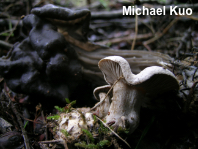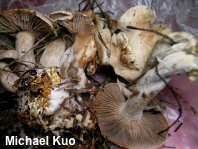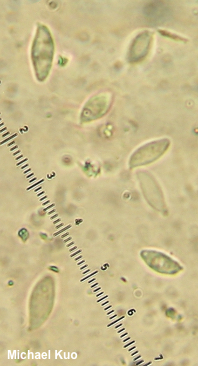| Major Groups > Mycotrophs > Clitocybe sclerotoidea |
| Major Groups > Gilled Mushrooms > Pale-Spored > Clitocyboid Mushrooms > Clitocybe sclerotoidea |

|
Clitocybe sclerotoidea [Basidiomycota > Agaricales > Tricholomataceae > Clitocybe...] by Michael Kuo Poor Helvella lacunosa. Despite being one of the coolest, funkiest mushrooms around, it just can't seem to catch a break. It is regularly parasitized by both Hypomyces cervinigenus and Clitocybe sclerotoidea. A gilled mushroom like Clitocybe sclerotoidea parasitizing an ascomycete is a bit of a novelty; usually it is the other way around–or the gilled mushroom parasitizes another gilled mushroom, as in the case of Entoloma abortivum, which attacks Armillaria mellea (though scientists used to think the parasitism was reversed). But Clitocybe sclerotoidea does, indeed, appear to "require Helvella-produced metabolites for initiation or maturation" of mushrooms (Trappe, 1972). Microscopic analysis of the large, swollen mass that is always at the base of Clitocybe sclerotoidea reveals the presence of cells from both species, and proves the direction of the parasitism. Clitocybe sclerotoidea is thus easily recognized by the fact that it grows with Helvella lacunosa in the Pacific Northwest and has a stem that arises from a swollen mass of tissue. Its dirty whitish cap, darkening gills, lack of a distinctive odor or taste, and microscopic features also help to distinguish it. Thanks to Jim Trappe for teaching me this mushroom. Description: Ecology: Parasitic on Helvella lacunosa; growing under conifers in clusters, often with malformed mushrooms also present; fall and winter (rarely in summer); Pacific Northwest. The illustrated and described collections are from California. Cap: 1–4 cm; convex, becoming planoconvex; bald to the naked eye but finely hairy with a hand lens; dirty whitish to pale grayish or brownish, often with watery spots; sometimes blackening in places with age or on handling; the margin at first inrolled. Gills: Attached to the stem or beginning to run down it; nearly distant; short-gills present; whitish at first, darkening to grayish brown. Stem: 1–3 cm long; 1–1.5 cm thick; more or less equal; finely velvety or hairy; arising from a swollen mass of fuzzy white tissue measuring up to 6 x 4 cm. Flesh: Whitish. Odor and Taste: Odor foul, or not distinctive; taste not distinctive. Chemical Reactions: KOH negative on cap surface. Spore Print: White. Microscopic Details: Spores 8–10 x 2.5–3.5 µm; subfusiform to fusiform; smooth; hyaline in KOH; inamyloid. Basidia 30–35 x 5–6 µm; subclavate; 4-sterigmate. Cystidia not found. Pileipellis a cutis or ixocutis; elements 2.5–5 µm wide, smooth, hyaline to yellowish in KOH, with clamp connections. REFERENCES: (Morse, 1943) Bigelow, 1958. (Trappe, 1972; Smith, 1975; Smith, Smith & Weber, 1979; Bigelow, 1982; Arora, 1986; Gregory, 2007; Kuo & Methven, 2010; Nguyen et al., 2013; Desjardin, Wood & Stevens, 2014; Siegel & Schwarz, 2016.) Herb. Kuo 01150501. This site contains no information about the edibility or toxicity of mushrooms. |
© MushroomExpert.Com |
|
Cite this page as: Kuo, M. (2021, May). Clitocybe sclerotoidea. Retrieved from the MushroomExpert.Com Web site: http://www.mushroomexpert.com/clitocybe_sclerotoidea.html |


